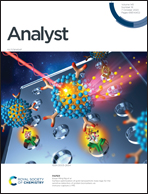Molybdenum disulfide nanosheets-based fluorescent “off-to-on” probe for targeted monitoring and inhibition of β-amyloid oligomers†
Abstract
A novel and simple “off-to-on” fluorescent sensing platform for β-amyloid oligomers (Aβo) was developed based on dye (FAM)-labeled single-strand DNA (FAM-ssDNA)-conjugated molybdenum disulfide nanosheets (MoS2 NSs). Due to strong adsorption of ss-DNA to the surface of MoS2 NSs, the fluorescence of FAM was quenched remarkably, leading to a fluorescent “off” state. However, in the presence of Aβo, a hybrid structure between Aβo and FAM-ssDNA resulted in the dissociation of FAM-ssDNA from MoS2 NSs and an obvious fluorescence recovery transformed the fluorescence to an “on” state. The developed fluorescence sensing assay showed a good linear relationship toward Aβo ranging from 0.01 to 20 μM (R2 = 0.994) with a satisfactory detection limit of 3.1 nM. Practical samples of hippocampus and cortex tissues from APP/PS1 double transgenic AD mice were applied to demonstrate feasibility of the assay. Moreover, we found that similar to MoS2 nanoparticles, MoS2 NSs possessed therapeutic effects on Alzheimer's disease (AD) by inhibiting Aβ aggregations and degrading the previously formed Aβ fibrils. Collectively, the high sensitivity, specificity, and good biocompatibility along with an efficient anti-aggregation ability, the presented fluorescent strategy with MoS2 NSs demonstrated their promising potential for future AD-related research.



 Please wait while we load your content...
Please wait while we load your content...